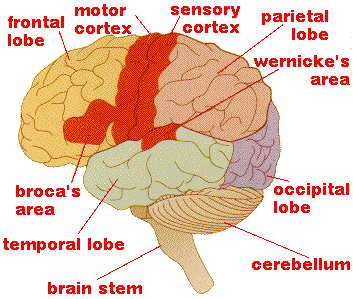|
|
|
Home Page
|
WELCOME TO MY HOME PAGE
|
||||||||||
|
|
|||||||||||
 |
Hi ,i welcome you once again to my home page,here in my page i have a special subjet for u on BIOLOGY ,CHEMISTRY AND PHYSICS but u will only have the chemistry , u can contact me for the remaining two subject .In BIOLOGY we talk about the BRAIN TUMOR and how it affect ,so pleas read through ,but if u want to print it u are free .And more over i just want to have a fath and believe in urself that u can achieve all what u want to achieved in this llife ,well as for me i have the faiht that i will make it in this life ,nothing ! nothing !abolutely nothing can distop my dream cos i have the faith . So lte move on .by the lefthand side ,the subject is there ... have a nice time as u read it ... stay cool This site describes enjoyable thing about the BRAIN, gives you background about their creation, and answers frequently asked questions. For example, at the left you'll see the daigramm for brain , which talk about the brain and the diseas called TUMOR . So, read on, and contact me if you have comments or suggestions! stay cool!!!! |
||||||||||
|
BRAIN TUMOR [biology]
MORE INFORMATION ABOUT THE BRAIN TUMOR |
|||||||||||
|
THE DIAGNOSIS OF THE BRAIN TUMOR! When a brain tumor is suspected, the first test a doctor gives is a traditional neurological examination. This exam is divided into several components each focusing on a different part of the nervous system. It evaluates eye movement, eye reflexes, and pupillary reactions, reflexes, hearing, sensation, movement, balance, and coordination. The neurological exam also includes a mental status exam, a series of questions designed to test cognitive ability, memory, and abstract thinking. In addition, the physician often orders additional specialized tests to come to a diagnosis. These techniques have dramatically improved the diagnosis of brain tumors in recent years and have replaced older tests, such as conventional X-rays, which do not show tumors located inside the skull or spine, and cerebral angiography. CT Scan (Computed Tomography Imaging) Computed Tomography, often called a “CT” or “CAT” scan, uses special X-ray equipment, which obtains images from different angles, and a computer that assembles them to create a detailed cross-sectional picture of the body’s tissues. These pictures are called “slices.” These slices provide more detailed information on brain tumors than conventional X-ray films. The CT scan is a painless, patient-friendly exam that requires no special preparation. The machine is large and square shaped with a patient-sized opening in the center. The patient lies still on a table which slides the patient in and out of the opening. Within the machine, an x-ray tube moves around the patient’s body to produce images – this causes a clicking and whirring noise. Depending on the number of images needed, a CT scan of the head and brain can take from 2 to 45 minutes. Sometimes an injection of dye, or contrast material, is injected prior to the scan to make abnormal tissue more obvious. Since contrast material concentrates more highly in diseased than in healthy tissue, it highlights abnormalities such as brain tumors. The injection of contrast material may cause some discomfort, and contrast agents contain iodine, which causes allergic reactions in some individuals. If you have had an allergic reaction to iodine or contrast material in the past, be sure to share this information with the technologist, nurse or radiologist. Although the amount of radiation in CT scanner is kept to a minimum, it is also important to inform your doctor if you are, or think you may be, pregnant. MRI Scan (Magnetic Resonance Imaging) Unlike conventional X-rays and CT scans, MRI does not use radiation. Instead, radio waves and a strong magnetic field are used to produce clear and detailed pictures of internal organs. The radio waves are directed at protons, the nuclei of hydrogen atoms. In the setting of a strong magnetic field, the protons become excited and then relaxed, emitting radio signals, which are then computer-processed to form an image. Since protons are most abundant in the hydrogen atoms of water, an MRI image shows differences in the water content in various body tissues. For example, different types of tissue within the same organ, such as the white and gray matter of the brain, can be distinguished. Small tumors, tumors next to bone, brain stem tumors, and low grade or metastatic tumors are often best imaged by MRI. The conventional MRI is a large piece of equipment - a closed cylindrical magnet which has an opening for the patient. Once inside the patient must lie absolutely still. MRI causes no pain, but the feeling of being closed-in can cause anxiety reactions, especially for people who are claustrophobic. This is a common reason for stopping an examination before it is completed. Fortunately, newer "open air" MRIs offer the opportunity to scan these patients. Patients are placed on a sliding table and a radio antenna, called a surface coil, is positioned around in the area to be scanned. The radiologist or technologist leaves the room while the MRI sequences are performed, but the patient can communicate with them via intercom. Many MRI centers allow patients to have someone stay in the room with them. If contrast material is used, there may be some discomfort at the injection site. No special preparation is needed for an MRI, but it’s important to know that the strong magnetic field will pull any implanted metal objects in the body. The MRI staff will ask about this; for example, do you have a prosthetic hip, pacemaker, or any metal plates, pins or surgical staples or wire? MRI is generally avoided during the first 12 weeks of pregnancy. There are also new scanning methods called hemodynamic imaging, which measure the rate of blood flow in the brain. Contrast dye is intravenously administered and the scanner starts taking a rapid succession of images – this traces the path of blood flow into the brain and brain tumor. MRI Angiography (MRA) uses MRI scans to outline blood vessels in the brain by following blood flow. Angiography is used to plan the surgical removal of a tumor suspected to have a large blood supply or one located in a part of the brain with dense blood vessels. Functional MRI or Fast MRI produces MRI images in a faster sequence than conventional MRI. This technique allows the tumor’s use of oxygen to be determined and is helpful in distinguishing between tumor and edema. The speedy production of images makes this technique useful for mapping specific areas of the brain during surgery. The images of Magnetic Resonance Spectroscopy, or MRS, depicts patterns of activity, rather than shape, and are helpful in diagnosing particular tumors and differentiating between radiation necrosis and tumor recurrence. PET Scan (Positron Emission Topography) A PET scan provides a picture of brain activity, rather than structure, by measuring levels of injected glucose (sugar) labeled with a radioactive tracer. After a low-dose of radioactive glucose is injected, a scanner rotates around the patient’s head and detects the amount of radioactivity in different parts of the brain. Different degrees of brightness and color represent different types of tissue or organ function. For example, cancerous tissue uses more glucose than healthy tissue, and consequently, appears brighter when scanned. A PET scan is not regularly used for diagnosing tumors, but is used with other scans to determine the grade of the tumor or distinguish between necrosis and scar tissue. The PET scanner has an opening in the middle and looks like a large doughnut. Patients are injected with the radioactive substance approximately 30 to 60 minutes before the scan. During this time, they are asked to rest quietly and remain still. The scan takes 30 to 45 minutes. Other than the discomfort of an injection, the radioactive substance will not cause any feeling. Like other scanning devices, being enclosed can make some patients feel claustrophobic. The radioactive tracer required for the PET has a very low radiation exposure and is short-lived. Although the exposure is low, it is important to notify the radiologist if there is a chance that you are pregnant. This scan is useful in that it allows physicians to detect alterations in body function that might indicate disease before changes can be seen in other types of scans. The drawback is that PET requires complex and expensive equipment that is only available in major medical centers. It can also give misleading results if a patient’s chemical balances are abnormal, such as in patients with diabetes. PET scans are more valuable when used in a larger diagnostic work-up in which they are compared with other imaging studies, such as CT and MRI scans. If you have any questions about how brain tumors are diagnosed, please call or email Director of Education and Support Sarah Gupta at 800.770.TBTS (8287), ext 25 or support@tbts.org. |
|||||||||||
|
LITTLE ABOUT THE BRAIN The brain is a delecate structure that we have to maintain ,and the brain is the most highly specialised organ .it is protected by SKULL or CRANIUM. The brain is made up of three [3] main part .These are FORE BRAIN, MID BRAIN and HIND BRAIN. The forebarin is made up of two main part called THALAMIN and HYPOTHALAMIN. And the mid brain consist of a small and inconspicuous part of the brain .it is very short region consisting of optics lobes,pinal body and pituitary gland.The hind brain together with the mid brain co-ordinates most of the body `s automatics in-voluntary activities .The hind brain is composed of the celebellum ,the pons varolii and the madullar oblongata. |
|||||||||||
|
FUNCTIONS OF FORE BRAIN ,MIDBRAIN AND HIND BRAIN.! THE FORE BRAIN! a}It is a seat of intellingent. b}The celebrum control all voluntary activities e.g movement of legs ,arms,speech e.c.t c}It is a seat of intellingent . THE MID BRAIN! a}The optics lobes recieve sensory impulses from the eye . b} It is the site of vision. c}It connects the the forebrain to the hind brain and thereby assist in transmission of impulses. THE HIND BRAIN! a}It co-ordinates the various muscle actions in involuntary actions b} It recieves impulses from auditory organs[semi-circular canal of the ear]and skin. c}The cerebellum controls posture or balance of the body...
FOR MORE INFORMATION ABOUT ME |
 |
||||||||||